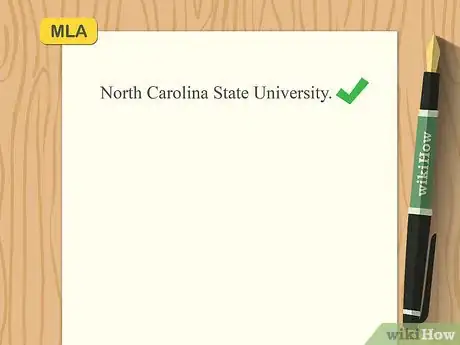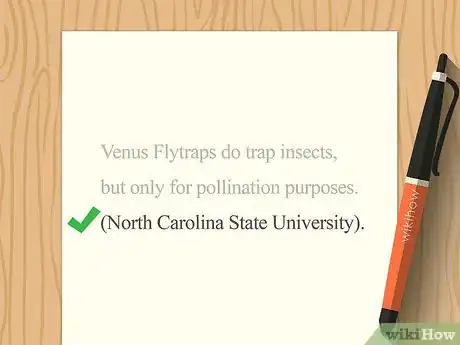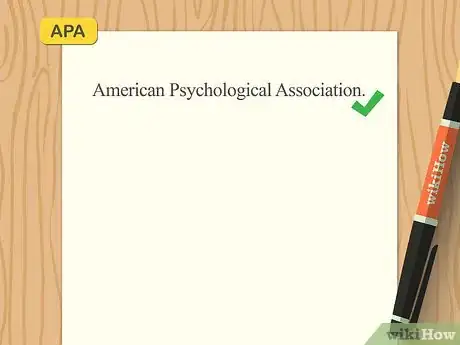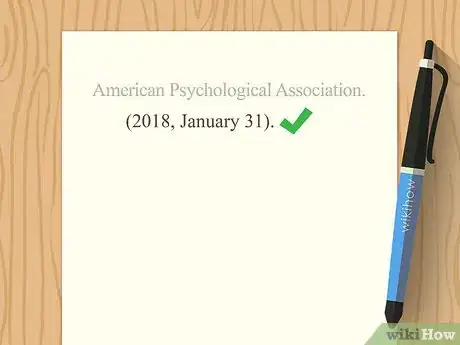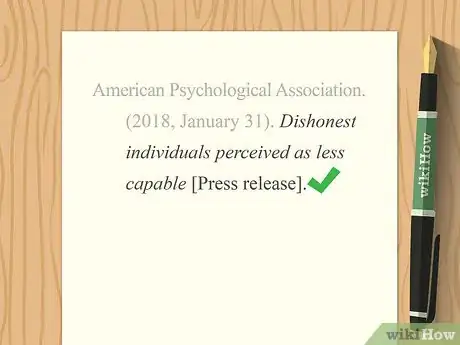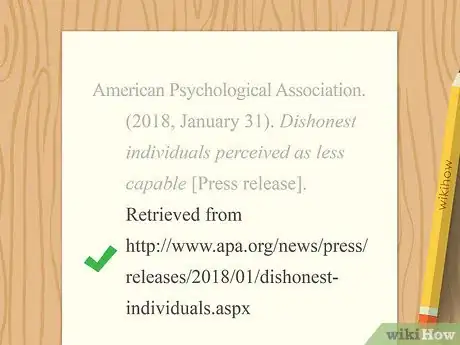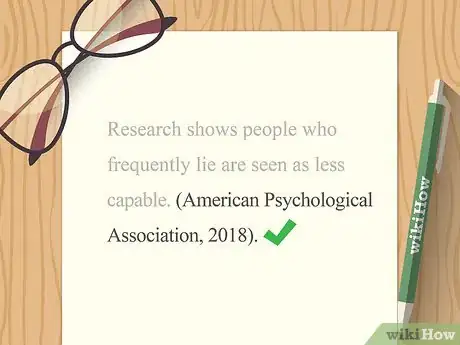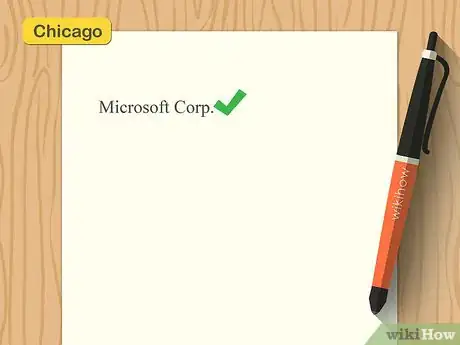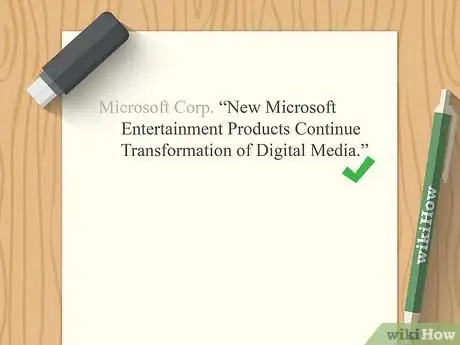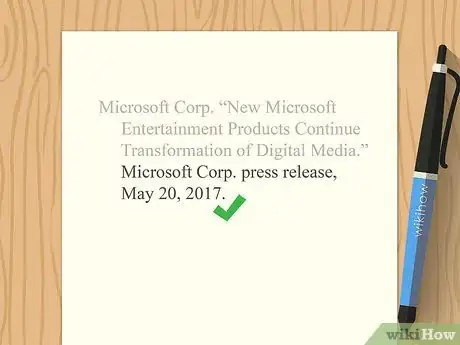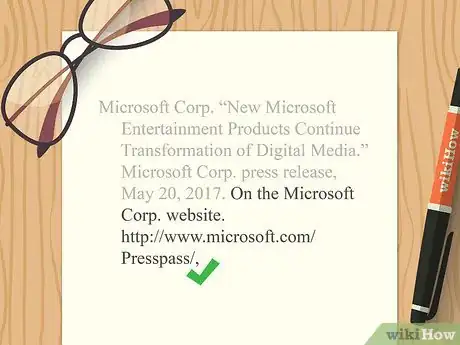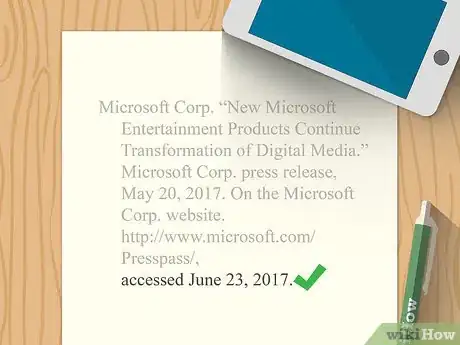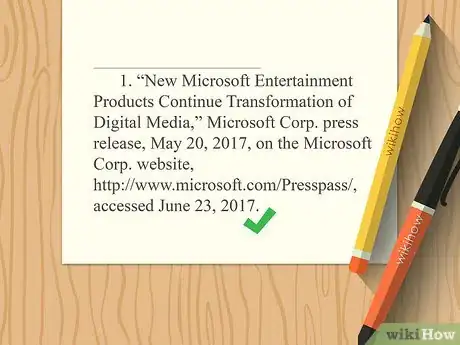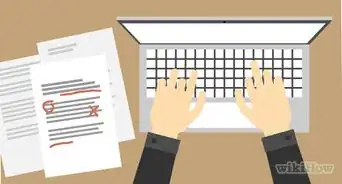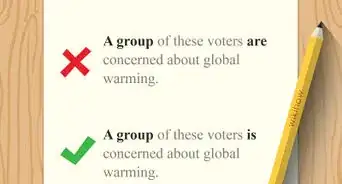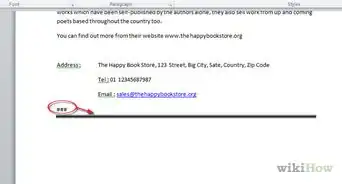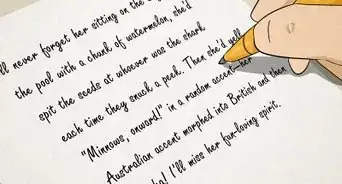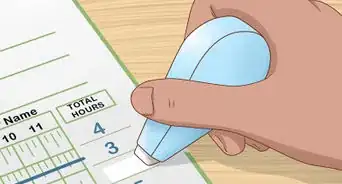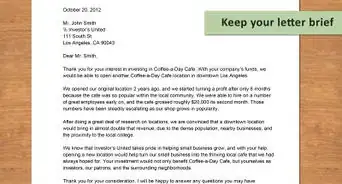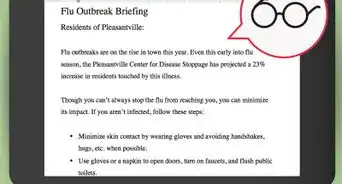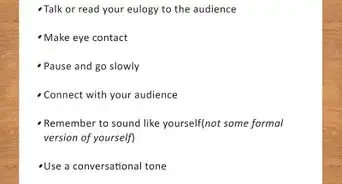This article was co-authored by wikiHow staff writer, Jennifer Mueller, JD. Jennifer Mueller is a wikiHow Content Creator. She specializes in reviewing, fact-checking, and evaluating wikiHow's content to ensure thoroughness and accuracy. Jennifer holds a JD from Indiana University Maurer School of Law in 2006.
This article has been viewed 31,752 times.
Learn more...
If you're writing a research paper or presentation about a business or organization, you may use press releases as references. This is particularly true if you're writing about a developing issue, where a press release may be the only documentation you have of recent events. Generally, the basic information included in your citation will be the same regardless of which formatting guidelines you use. However, the format of your citation may differ somewhat, depending on whether you use the Modern Language Association (MLA), American Psychological Association (APA), or Chicago style.
Steps
MLA
-
1List the name of the organization that issued the press release. An entry in your "Works Cited" typically begins with the name of the author. However, for a press release, you'll use the name of the business, organization, or government agency that issued the press release as the author. Place a period at the end of the organization's name.
- Example: North Carolina State University.
- For government agencies, start with the name of the state or country, then list the overall department, then the specific division or agency within that department. For example: United States, Health and Human Services Department, Centers for Disease Control and Prevention.
-
2Provide the title of the press release in quotation marks. Include the title or headline for the press release using title case. Generally, capitalize all nouns, pronouns, adjectives, verbs, adverbs, and any words more than 4 letters long. Place a period at the end of the title, inside the closing quotation marks.
- Example: North Carolina State University. "Venus Flytraps Don't Eat the Insects That Pollinate Them."
Advertisement -
3Provide the date of the press release. After the title, put the words "Press Release" in italics after the name of the organization that released the press release. The correct format can typically be found at the top of the press release. Place a comma, then type the date the press release was issued in day-month-year format. The date should not be italicized. Place a period after the date.
- Example: North Carolina State University. "Venus Flytraps Don't Eat the Insects That Pollinate Them." N.C. State U. Press Release, 6 Feb. 2018.
- If the organization is commonly known by an abbreviation or acronym, use that for the second mention of the organization. For example, if you were citing a press release from the U.S. Centers for Disease Control and Prevention, you would use the acronym "CDC" here.
-
4Copy the URL or other location of the press release. If you accessed the press release online, close your "Works Cited" entry with the URL where the press release can be found. Leave off the "http://" portion of the URL. Place a period at the end of the URL. Type the word "Accessed," then provide the date you accessed the press release at that location, in day-month-year format. Close your citation with a period.
- Example: North Carolina State University. "Venus Flytraps Don't Eat the Insects That Pollinate Them." N.C. State U. Press Release, 6 Feb. 2018. www.sciencedaily.com/releases/2018/02/180206140655.htm. Accessed 28 Aug. 2018.
-
5Use the organization's name for in-text citations. MLA uses parenthetical citations to refer your readers to the full citation of the source in your "Works Cited." Typically, the parenthetical citation includes the name of the author and the page number. However, since press releases typically don't have page numbers, simply placing the name of the organization in parentheses will suffice.
- Example: "Venus Flytraps do trap insects, but only for pollination purposes. (North Carolina State University)."
APA
-
1Type the name of the organization that issued the press release first. The usual entry in an APA reference list begins with the author of the work being cited. For a press release, the author is always the business, organization, or government agency that released it. Type that name exactly as it appears on the press release, then place a period at the end.[1]
- Example: American Psychological Association.
-
2Provide the date the press release was issued in parentheses. The APA typically only requires the year of publication. However, when citing a press release, you need to be a little more specific. Start with the year, then place a comma. After the comma, type the month and day the press release was issued. Place a period after the closing parentheses.[2]
- Example: American Psychological Association. (2018, January 31).
-
3Include the full title of the press release. Following the date the press release was issued, type the title of the press release in italics. Use sentence-case, capitalizing only the first word and any proper nouns in the title. After the title, include the description "Press release" in square brackets. The bracketed description should not be italicized. Place a period after the closing brackets.[3]
- Example: American Psychological Association. (2018, January 31). Dishonest individuals perceived as less capable [Press release].
-
4Copy the direct URL for the press release. Begin the last part of your citation with the phrase "Retrieved from," then copy the permanent URL where the press release can be found online. Do not place a period at the end of the URL.[4]
- Example: American Psychological Association. (2018, January 31). Dishonest individuals perceived as less capable [Press release]. Retrieved from http://www.apa.org/news/press/releases/2018/01/dishonest-individuals.aspx
-
5Use author-year format for in-text citations. When you paraphrase or quote the press release in the body of your paper, provide a parenthetical citation that includes the name of the organization that issued the press release and the year it was released. Separate these parts of your in-text citation with a comma.[5]
- Example: "Research shows people who frequently lie are seen as less capable. (American Psychological Association, 2018)."
Chicago
-
1List the name of the organization that issued the press release first. The organization that issued the press release is considered the "author" of the press release. In your reference list, type the name exactly as it appears on the press release, then place a period at the end.[6]
- Example: Microsoft Corp.
-
2Provide the title of the press release in quotation marks. After the name of the organization that issued the press release, type the title in title-case. Capitalize all nouns, pronouns, adjectives, verbs, and adverbs that appear in the press release's title. Place a period at the end of the title, inside the closing quotation marks.[7]
- Example: Microsoft Corp. "New Microsoft Entertainment Products Continue Transformation of Digital Media."
-
3Include the date when the press release was issued. Begin the next part of your bibliographic citation by identifying the document as a press release of the organization you listed as the author. Place a comma, then provide the date the press release was issued in month-day-year format. Place a period after the year.[8]
- Example: Microsoft Corp. "New Microsoft Entertainment Products Continue Transformation of Digital Media." Microsoft Corp. press release, May 20, 2017.
-
4Identify the location of the press release. Typically, you'll access the press release online. Provide the name of the website where you found the press release, then place a period. After the period, provide the URL where the press release can be found. Type a comma after the URL.[9]
- Example: Microsoft Corp. "New Microsoft Entertainment Products Continue Transformation of Digital Media." Microsoft Corp. press release, May 20, 2017. On the Microsoft Corp. website. http://www.microsoft.com/Presspass/,
-
5Include the date you accessed the press release. After the comma that follows the URL, use the word "accessed" and then type the date you last accessed the press release at that URL, using month-day-year format. Place a period at the end of the date to close out your bibliographic citation.[10]
- Example: Microsoft Corp. "New Microsoft Entertainment Products Continue Transformation of Digital Media." Microsoft Corp. press release, May 20, 2017. On the Microsoft Corp. website. http://www.microsoft.com/Presspass/, accessed June 23, 2017.
-
6Alter your format for footnotes to the body of your work. When you paraphrase or quote the press release in the body of your paper, you'll need to place a footnote at the end of that sentence. The footnote includes the same information as the bibliographic entry, but in a slightly different format. Primarily, list the title of the press release first, rather than the organization that issued it.[11]
- Example: "New Microsoft Entertainment Products Continue Transformation of Digital Media," Microsoft Corp. press release, May 20, 2017, on the Microsoft Corp. website, http://www.microsoft.com/Presspass/, accessed June 23, 2017.
References
- ↑ http://blog.apastyle.org/apastyle/2010/09/how-to-cite-a-press-release-in-apa-style.html
- ↑ http://blog.apastyle.org/apastyle/2010/09/how-to-cite-a-press-release-in-apa-style.html
- ↑ http://blog.apastyle.org/apastyle/2010/09/how-to-cite-a-press-release-in-apa-style.html
- ↑ http://blog.apastyle.org/apastyle/2010/09/how-to-cite-a-press-release-in-apa-style.html
- ↑ http://blog.apastyle.org/apastyle/2010/09/how-to-cite-a-press-release-in-apa-style.html
- ↑ https://www.anderson.ucla.edu/rosenfeld-library/citing-business-sources#press
- ↑ https://www.anderson.ucla.edu/rosenfeld-library/citing-business-sources#press
- ↑ https://www.anderson.ucla.edu/rosenfeld-library/citing-business-sources#press
- ↑ https://www.anderson.ucla.edu/rosenfeld-library/citing-business-sources#press
